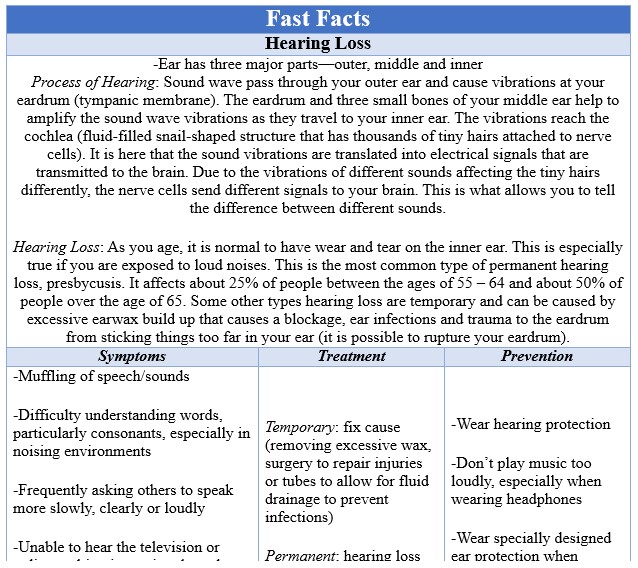What is wrong with your hearing?
While the stereotypical image of elderly people is that they are hard of hearing, this isn’t always the case. Most of us take the ability to hear for granted until we have difficulty hearing. How common is hearing loss as you age? Is it permanent? Are there things that you can do to help prevent it?
 Definition
Definition
In order to understand hearing loss, it is essential to understand the process of hearing. Your ear consists of three major parts—outer, middle and inner. Sound wave pass through your outer ear and cause vibrations at your eardrum (tympanic membrane). The eardrum and three small bones of your middle ear help to amplify the sound wave vibrations as they travel to your inner ear. The vibrations reach the cochlea (fluid-filled snail-shaped structure that has thousands of tiny hairs attached to nerve cells). It is here that the sound vibrations are translated into electrical signals that are transmitted to the brain. Due to the vibrations of different sounds affecting the tiny hairs differently, the nerve cells send different signals to your brain. This is what allows you to tell the difference between different sounds.
As you age, it is normal to have wear and tear on the inner ear. This is especially true if you are exposed to loud noises. This is the most common type of permanent hearing loss, presbycusis. It affects about 25% of people between the ages of 55 – 64 and about 50% of people over the age of 65. Some other types hearing loss are temporary and can be caused by excessive earwax build up that causes a blockage, ear infections and trauma to the eardrum from sticking things too far in your ear (it is possible to rupture your eardrum). Typically, symptoms of hearing loss include muffling of speech and other sounds which can make it difficult to understand words, particularly consonants, especially in noising environments. In order to understand others better, you might frequently ask them to speak more slowly, clearly and/or loudly. It can also be difficult to hear the television or radio resulting in turning the volume up in order to do so. Sometimes, people with hearing loss will withdraw from conversations or avoid social settings due to their hearing loss and they’re embarrassment or frustration with it.
Treatment
Temporary hearing loss is treated by fixing the cause. For blockages caused by excessive ear wax, the solution is simple…remove the blockage. If you have an injury to your ear, you may need surgery to repair the damage. If you get frequent ear infections, having tubes placed can help to facilitate the drainage of fluid from your ears and decrease the chances of getting ear infections. This is especially helpful for children since they are prone to getting ear infections due to the shape of their ear canal, which is smaller and more angled than an adult.
Permanent hearing loss can’t not be restored, so the treatment is to help the person hear better by using devices. Hearing aids help to amplify sounds by making them stronger and this makes it easier to hear. There are various different types that are available but all have a piece that is inserted into the ear canal. For severe types of permanent hearing loss where parts of the inner ear are non-functioning, there are cochlear implants. These require surgery and parts of the device are permanently implanted inside the ear.
Prevention
The biggest way to prevent hearing loss is through protection. You should start while you’re still young. This means wearing hearing protection when you know that you are going to be around things that are loud. It is also important to take breaks from activities that are loud and can cause damage to your inner ear. If you listen to music, don’t play it too loudly, especially if you are wearing any type of headphones. When working in environments that have loud machines, it is vital to wear specially designed ear protection the bring most loud noises down to an acceptable level. These can include foam, pre-formed or custom-molded earplugs made of rubber or plastic. If you work in a noisy area, it is a good idea to have your hearing tested frequently to check to see if you are experiencing hearing loss and take measures to prevent further loss. Remember, any sound under 80 decibels is considered in the safe range and these include things such as whispering, normal conversations or washing machine noise. Anything from 80-119 decibels is considered the at-risk range and include noises like heavy city traffic, motorcycles, hand drills or rock concerts. Any noise that is 120 decibels or above is loud enough to cause injury and are sounds like an ambulance siren, jet engine at takeoff, shotgun blast or rocket launch. It is important to note that you experience pain in your ears when noises reach 140 decibels or more.
Hearing loss might not be completely preventable, but there are things that you can do to decrease the severity of it. The good news is that there are treatment options available in order for you not to live your life in silence. If you have any questions or concerns about hearing loss, please speak with your doctor. If you would like more information about it, please visit the Hearing Loss Association of America at http://www.hearingloss.org/